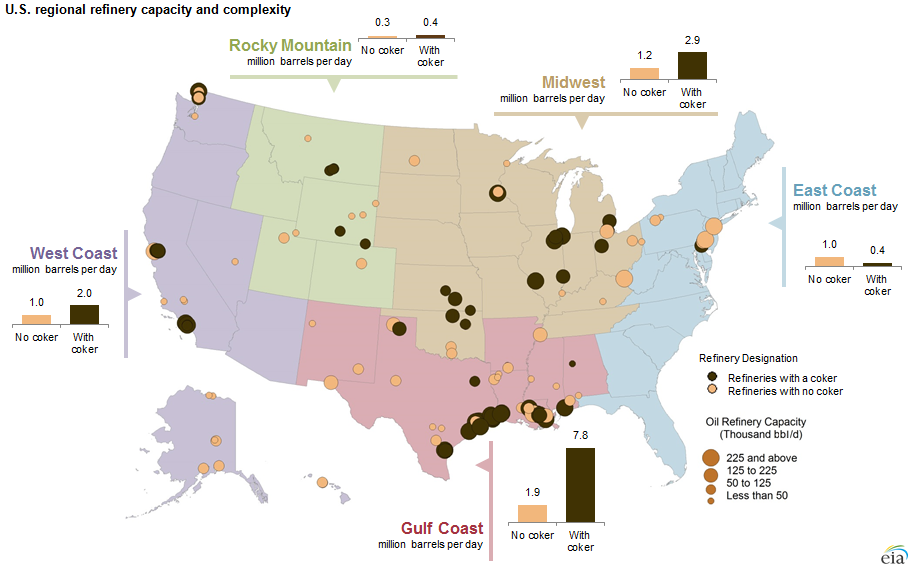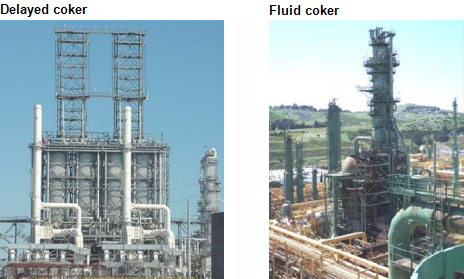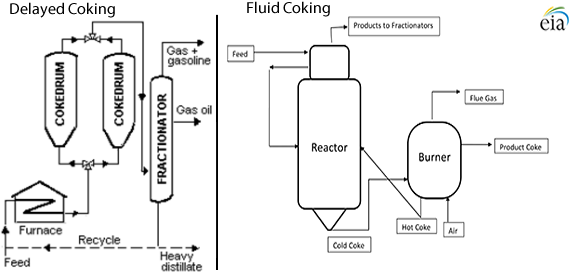Skip to comments.
Regional refinery trends evolve to accommodate increased domestic crude oil production
Energy Information Administration ^
| Jan 15, 2015
| Energy Information Administration
Posted on 01/18/2015 11:36:36 AM PST by thackney
Recent rapid growth in U.S. production of light tight oil has raised interest in understanding how U.S. refineries, many of which are configured to process heavier crude oil, might accommodate increased volumes of domestic light crude. The U.S. refinery fleet, which is distributed across Petroleum Administration for Defense Districts (PADDs), varies both within and across regions in capacity, quality of crude oil inputs, utilization rates, and sources of crude supply.
More than 50% of the country's refinery capacity and most of the country's heavy crude processing capacity is located in the Gulf Coast (PADD 3). The region's 51 operating refineries with atmospheric crude distillation units (ACDU) have capacity totaling 9.7 million barrels per stream day (bbl/sd), 81% of which is located at facilities with coking capacity. Coking units can upgrade heavy crude oil into higher-valued lighter products, such as distillate and gasoline.
Recent expansions have increased ACDU and coking capacity by 625,000 bbl/sd and 160,000 bbl/sd, respectively, since 2010. Despite the expanded capacity, utilization has remained steady, and the region has recently set records for high levels of gross inputs.
Changes to crude oil supply patterns are most pronounced in the Gulf Coast. Net imports into the region have fallen by 2.3 million bbl/d, and light sweet crude imports have been largely replaced by domestically produced light, tight oil. In addition, from 2010 to 2014, the average API gravity of crude inputs rose by 1 degree. API gravity is an inverse measure of the density of a petroleum liquid relative to water, meaning that the higher the API gravity, the lower the density of the petroleum liquid compared to water. An increase in API gravity indicates that average crude slates are becoming lighter.
Crude oil production in the Gulf Coast region has increased by 1.9 million barrels per day since 2010. Gulf Coast receipts of crude oil from the Midwest (PADD 2), including both U.S. and Canadian production, also have increased. With more Canadian and domestic barrels moving south from the Midwest to the Gulf Coast region and lower demand for crude shipments from the Gulf Coast to the Midwest, net receipts for the Gulf Coast were positive in October 2014 for the first time since December 1985. This situation, with shipments and receipts of crude oil to and from other PADDs being roughly equal in the Gulf Coast region, is a change from the region's traditional role. The Gulf Coast has long been a source of crude supply for neighboring PADDs, both through the movement of domestic production and from imported crude oil coming into Gulf Coast ports.
With U.S. crude production in 2015 expected to average 9.3 million bbl/d, 700,000 bbl/d above the 2014 level, domestic refiners will continue to face changing supply and demand conditions, even as continued production growth in the first months of the year transitions to a more static production outlook as the effects of the recent sharp decline in oil prices are reflected in drilling decisions. Changes to infrastructure, refinery capacity, crude oil price differentials based on quality, and policy decisions will also affect refinery operations in the coming year. Further discussion of these changing dynamics for each region of the country can be found in the January 7 This Week in Petroleum.
TOPICS: News/Current Events
KEYWORDS: energy; oil; refinery

Source: U.S. Energy Information Administration Note: As of January 1, 2014, there were 133 operating refineries with atmospheric crude oil distillation units (ACDU) totaling capacity of 18.9 million barrels per stream day. Heavy capacity denotes refineries with coking capacity; light capacity denotes refineries without coking capacity.
- - - - -
What is stream day capacity?
Stream day capacity is the maximum number of barrels of input a distillation facility can process within a 24-hour period when running at full capacity under optimal crude and product slate conditions with no allowance for downtime. The stream day capacity is typically about 6% higher than the calendar day capacity, which reflects usual operating conditions including both planned and unplanned maintenance.
- - - - -
Coking is a refinery process that produces 19% of finished petroleum product exports
http://www.eia.gov/todayinenergy/detail.cfm?id=9731
Coking is a refinery unit operation that upgrades material called bottoms from the atmospheric or vacuum distillation column into higher-value products and, as the name implies, produces petroleum coke—a coal-like material. Exports of petroleum coke accounted for about 19% of the nation's finished petroleum product exports through October 2012 with most going to China and other Asian countries.
Petroleum coke has uses in the electric power and industrial sectors, as fuel inputs or a manufacturing raw material used to produce electrodes for the steel and aluminum industries. In 2011, the refining industry supplied 132 million barrels of petroleum coke with most of it subsequently consumed as fuel. Two types of coking processes exist—delayed coking and fluid coking. Both are physical processes that occur at pressures slightly higher than atmospheric and at temperatures greater than 900oF that thermally crack the feedstock into products such as naphtha and distillate, leaving behind petroleum coke. Depending on the coking operation temperatures and length of coking times, petroleum coke is either sold as fuel-grade petroleum coke or undergoes an additional heating or calcining process to produce anode-grade petroleum coke.
With delayed coking, two or more large reactors, called coke drums, are used to hold, or delay, the heated feedstock while the cracking takes place. Coke is deposited in the coke drum as a solid. This solid coke builds up in the coke drum and is removed by hydraulically cutting the coke using water. In order to facilitate the removal of the coke, the hot feed is diverted from one coke drum to another, alternating the drums between coke removal and the cracking part of the process. With fluid coking, the feed is charged to a heated reactor, the cracking takes place, and the formed coke is transferred to a heater as a fluidized solid where some of it is burned to provide the heat necessary for the cracking process. The remaining coke is collected to be sold.
Like other secondary processing units, coking can play an important role in refinery economics depending on the type and cost of the crude oil run at a refinery. As the quality of crude oil inputs to a refinery declines, coupled with greater demands for transportation fuels, coking operations will serve to meet transportation fuel demands and also produce increasing quantities of fuel-grade and anode-grade or needle petroleum coke.


1
posted on
01/18/2015 11:36:36 AM PST
by
thackney
To: thackney
2
posted on
01/18/2015 1:25:03 PM PST
by
kiryandil
(making the jests that some FReepers aren't allowed to...)
To: thackney
George Skakel, father of Ethel Kennedy, made his fortune in petroleum coke.
http://en.wikipedia.org/wiki/George_Skakel
Skakel began his career as a railroad shipping clerk earning $8 a week.[3] While employed by the railroad, he noticed the price volatility of coal fines for coke, which is a byproduct of producing more-in-demand forms of coal. At most times, the coal mining companies were forced to store the coke or pay to have it disposed of in rivers. Skakel came up with an idea to purchase the coke from coal companies. In May 1919, Skakel and two partners put up $1,000 and established The Great Lakes Coal & Coke Company.[4] The company would purchase the coke from coal companies and then reprocessed the coke into clean carbon which was used to produce aluminum. By 1929, Skakel had become a multi-millionaire.[5] The business eventually grew into The Great Lakes Carbon Corporation, which became the one of the largest privately held corporations in the United States. After Skakel’s death in 1955, his sons George Jr. (who also died in a plane crash, in 1966) and James III took over the business.[6]
3
posted on
01/18/2015 1:35:03 PM PST
by
abb
("News reporting is too important to be left to the journalists." Walter Abbott (1950 -))
To: thackney
I’ve done my turn in coke units.
4
posted on
01/18/2015 5:45:42 PM PST
by
marron
To: marron
How bad did you experience the black dust?
5
posted on
01/18/2015 5:58:17 PM PST
by
thackney
(life is fragile, handle with prayer)
To: thackney
I’m not sure how I always drew short straw. Its nasty, of course.
I worked in two. The first, years ago, was bad. It also caught fire which was one for the books. Later I was in another which was black but not nearly as nasty.
6
posted on
01/18/2015 6:48:29 PM PST
by
marron
To: marron
I worked on a design team that did several of those, some really big.
7
posted on
01/18/2015 6:54:21 PM PST
by
thackney
(life is fragile, handle with prayer)
To: thackney
I was in refinery-based design teams in a couple of different plants over the years, and it so happened in two different refineries my area was the operating coker so I spent quite a lot of time in them.
Actually, come to think of it, my biggest project was an enormous coker overseas, but I was only there during final construction and checkout, I left before actual start-up.
8
posted on
01/18/2015 7:38:29 PM PST
by
marron
To: thackney
Is adding cokers to a refinery one of the ways to help the refinery handle heavier, low API, crudes? What are the other retrofits required?
When refineries were retrofitted to handle heavier crudes, did that make them less able to handle lighter crudes? Would not a coker always be useful, to a certain extent?
What is the industry doing with all that new light tight crude, for which many refineries are not optimized?
To: Kennard
Is adding cokers to a refinery one of the ways to help the refinery handle heavier, low API, crudes? What are the other retrofits required? Keep in mind, the refineries are designed for more specifics than heavy or light. And a coker is just one way to handle heavy oil. The balance of process has to happen from first distillation to the last processing unit. The pumps, pipes, control valves, etc all need to be sized to efficiently handle the volumes each unit will see.
Margins in refineries are tight. They use a lot of energy. When you operate outside the design point, you spend more money than your competition. You don't want to spend a billion dollars upgrading your refinery and not buy cheaper oil to pay for the upgrade.
For now, the additional light crude produced domestically has replaced light crude from places like Nigeria. But we are reaching a point where there is little light sweet imports left to offset.
10
posted on
01/19/2015 4:53:59 AM PST
by
thackney
(life is fragile, handle with prayer)
Disclaimer:
Opinions posted on Free Republic are those of the individual
posters and do not necessarily represent the opinion of Free Republic or its
management. All materials posted herein are protected by copyright law and the
exemption for fair use of copyrighted works.
FreeRepublic.com is powered by software copyright 2000-2008 John Robinson


